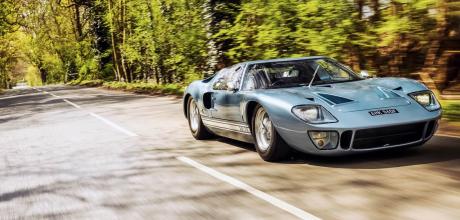1967 Ford GT40 MkI road car
The Ford GT40 earned its place in motoring history via Le Mans success, but not all were destined for competition. Today we see how this rare road car copes with the realities of street life in 2023.
Words IVAN OSTROFF
Photography TONY BAKER
Trip to the shops in a GT40? You’re kidding, right? OK then...
Streetwise What to do with a rare Ford GT40 road car? Take it to the shops, obviously...
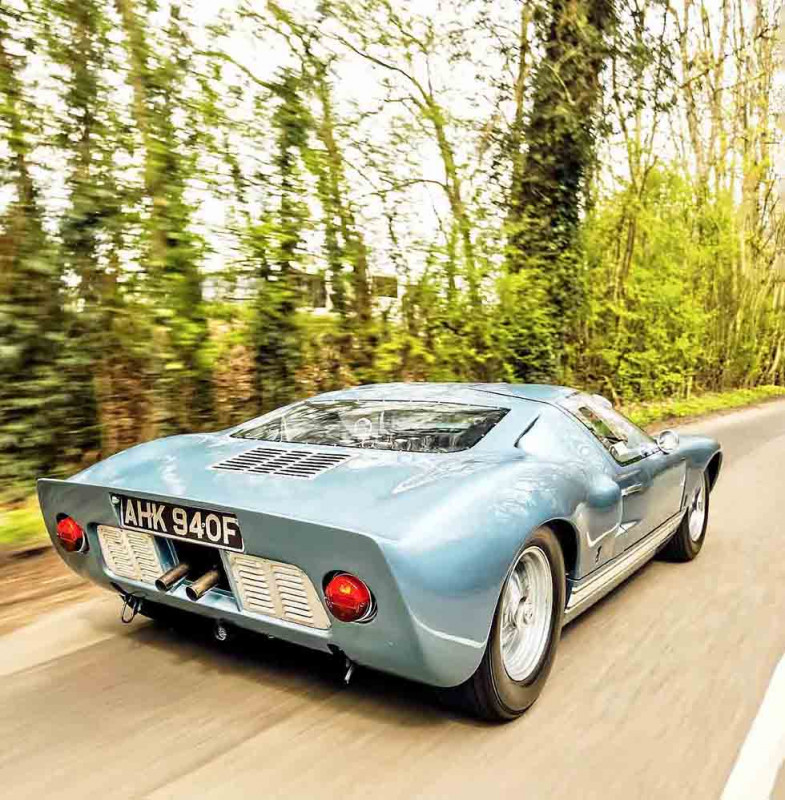
You can take it shopping if you like,’ says Kev Kivlochan – an offer even more surreal than his earlier suggestion of driving his 1967 GT40 on the road. But it’s actually a perfectly rational one. This car, chassis P/1069, was one of six MkI GT40s documented as being chosen to be sent to Carroll Shelby as road demonstrators and promotional vehicles. While it did see the racetrack later in life, its legacy as the ‘Filipinetti Hostage Car’ is the most intriguing; its encounter with Graham Hill a close second.
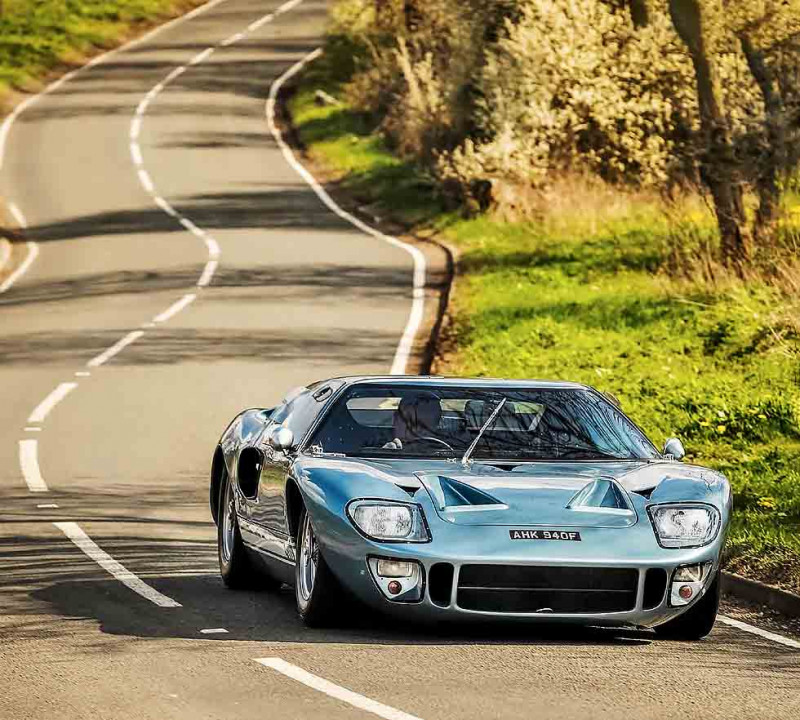
‘The 240mph speedo is visible enough to your passenger to give them heart failure’
More on that later; for now it’s time to take Kev up on his offer before he changes his mind. I press the raised end of the chromium door handle, the slim handle pops up, I curl my fingers around it and open the driver’s door, which takes half the roof with it. It’s quite a drop down into the car but at least not being a racer, there is no safety cage to negotiate. The aluminium slotted spoke steering wheel isn’t removable, however, so I sit on the wide sill, guide my left leg under the wheel into the footwell and then lower myself in.

Apparently the original leather road car seats have long since disappeared, instead it now has more recognisable GT40 ventilated racing items. With the five-point harness secure, I survey the cockpit. Instrumentation is very businesslike. The speedo to my far left shows 240mph and while angled driverwards, is visible enough to your passenger to give them heart failure. To its right are several standard-issue instruments including a pair of fuel gauges – for the tanks housed in each sill – plus a corresponding toggle switch to choose between them. Bang in front of me is a tachometer reading to 10,000rpm but marked with a marked redline at 6000, then among the various switchgear – and next to the all-important cigar lighter – is a simple ignition key starter switch.
‘Filipinetti had effectively held the GT40 hostage for six months between March and August 1967’
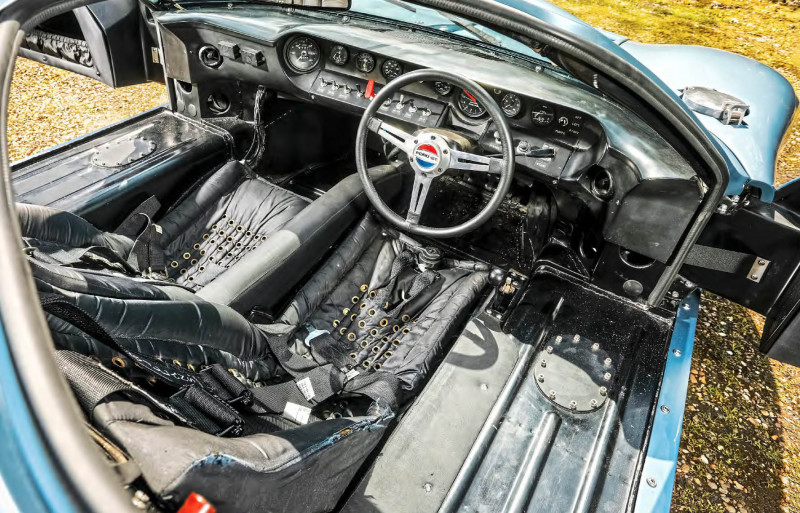
I twist the key, the 4.7-litre Ford V8 fires, I give the throttle a prod to help feed those four great double-choke Weber 48IDA carburettors and the engine coughs into a thunderous bellow. For what it’s worth I adjust the rear-view mirror while the V8 warms and settles to an impatient idle, but it’s rather like squinting backwards through a letterbox. The side mirrors are positioned as well as they can be, but again not a great deal of help. Although the seats are very reclined out of packaging necessity, I can reach the pedals well enough and my hands can embrace the leather-rimmed wheel at an ideal ten-to-two.
The stubby gear lever for the five-speed ZF gearbox is placed in the right sill and is perfectly sited. First is in the dog-leg down position and to safeguard the driver from damaging the gearbox, there’s an aluminium lever to flip before you can slide forward into reverse. As I trickle through the built up area, I hold the gearbox in second and maintain a 2000rpm minimum. With 375lb of torque, I’m tempted to slip into a higher gear but though a road car it may be, Kev forewarned me about its cammy nature; if I let the rpm drop the big Ford V8 will run rich and simply foul its plugs.
Once out on the open road, I can get out of second gear at last. The gearbox is smooth and the lever slides in and of out ratios keenly and crisply. Being an all-synchromesh ’box, it’s not necessary to double de-clutch, but why break the habit of a lifetime when it’s accompanied by such a magnificent concerto?
Braking power from the ventilated discs – inboard at rear – is impressive; feel through the pedal is excellent and the car shakes off speed confidently without any hint of front-end lock up thanks to a sweetly set braking balance honed through endurance racing. Sweeping through some fast bends, the car is neutral in its handling and has hardly any roll, it feels planted and flat. Although it weighs less than 1000kg, somehow I get a sense of mass from the car. Unlike a lighter mid-engine racer such as a Chevron, where you can hold the steering wheel between your fingers, the GT40 is a substantial piece of kit that requires you to grip the wheel firmly. Having driven similar cars on a track I’m aware that if I were foolish enough to provoke the back end to let go, it could bite hard. But that’s unlikely at road speeds with such great parameters of grip.
Kevin said to take it shopping, so I negotiate some urban sprawl and pull into the car park of a local Tesco. Reversing into the slot is hardly an easy task, I can’t see a wretched thing through the letterbox behind me, and the side mirrors contribute little more. Did it though – phew!
A stroll through the aisles gives my nerves and heart rate chance to return to their baselines, and I take the opportunity to consider the car’s history – and the events that gave this GT40 its unique legacy. Ronnie Spain, GT40 expert and author of the book GT40 — An Individual History and Race Record, has thoroughly examined P1069 and confirms its identity. According to documents that Spain has, it appears that in February 1967, at the ‘Mk1 Meeting covering Promotion and Disposal Program’, JH McQueen of Ford’s GT Sports Car Department was part of the coordinating programme to ship Ford GT P/1069 together with five other GT40s to the USA for the attention of Shelby American’s L Spencer who was charged with looking after ‘Special Events and Competition’ for a ‘promotional program’.
At this time P/1069 was painted in its original pale blue. After what seems to have been some period of promotional work across the pond, the next sight we have of P/1069 is when, inexplicably repainted Borneo Green, it was delivered by John Wyer of Automotive Engineering Ltd, to Claude F Sage at Scuderia Filipinetti to be displayed on its stand at the 1967 Geneva Motor Show. That’s where things got interesting.
Although it had been agreed that P1069 was to be returned to John Wyer after the show, Wyer owed Scuderia Filipinetti money for work it had carried out on two other GT40s, so Filipinetti made it clear that it would not return this car until the bill was cleared. Ronnie Spain has a copy of a letter from Wyer to Claude Sage, dated 8 May 1967, in which he writes, ‘Regarding Car No.1069, which you had at the Geneva Show, this is now wanted for the Ford programme and I shall be glad if you would arrange to have it returned to me as soon as possible.”’
In August, Jacques Loew replied for Claude Sage that Wyer owed £2641 for work on chassis P1040 and £430 for work on P1033, so P1069 was going nowhere. Eventually Wyer paid up and the car was returned. Filipinetti had effectively held the GT40 hostage for six months between March and August 1967. In 1968, chassis 1069 also featured in a men’s fashion magazine supplement, then in Autocar on 26 Dec 1968, and in Motor on 30 January 1969, which reported that it covered a quarter of a mile from standstill in 12.4 seconds and 0-100mph in 9.1.
In 1969, it was displayed once again at the Geneva show, but this time by Ford. Also at some point during that year Graham Hill was photographed getting into the car by together with a Ford executive while the car was at Jackie Oliver's dealership. He can be seen strapping himself in so we assume that he drove P1069 but there are no records of his comments. Perhaps he went shopping as well.
Over the years P1069 has passed through several hands. It was bought from Ford UK by Anthony Bamford in August 1971 who promptly repainted the car in his JCB colours, as yellow as the lemons I’ve just walked past in the fruit aisle. Robert Danny owned the car in July 1972. It then passed through the hands of Bruce Ropner, Frank Sytner and Gregor Fisken, who sold it to Frenchman Thierry Moriceau. Conrad Ulrich of Switzerland.
Unlike most of its brethren, this car’s competition outings had been infrequent. On 8 September 1973 Adrian Hamilton won the Brighton Speed Trials. In 2004 Moriceau placed 13th in a historic race at Monza then Ulrich raced it at Mugello to 14th position. Thereafter it became a regular at the Goodwood events. Kevin Kivlochan bought it in 2020, sending it to Richard Walbyoff at Racing Services Ltd. His brief was to restore the car back to its road-going specification.
Emerging from Tesco’s with the shopping I realise there is no real boot. Ford did originally fit two luggage boxes under the tail but these are no longer with the car. Fortunately we’re not carrying a spare wheel so I undo the four Dzus fasteners holding down the front panel and stuff the bags in there. By now I have something of an audience. ‘Is it real or a kit?’ ‘It’s real,’ I answer. ‘Wow! How long you had it?' ‘Not mine I’m afraid. I wish!’
Back in the hotseat I strap in and twist the key again. The V8 blasts into life, the shelves in Tesco shake, I slip the lever back into first and trickle forward trying, without success, not to be too noisy. The clutch is has a tiny window of bite, so trundling slowly through the car park is a bit of an ordeal. Back on the road again and sweeping through some uphill esses, I’m now feeling confident and enjoying the car. As I approach a 45-degree righthander, I slip the stubby gear lever forward into third and let the torque do the rest. Twin exhausts bellow their harmony as the GT40 powers through the corner in a gentle drift, enjoying the mildest of slides, while still retaining control. The back end behaves impeccably, without any hint of snap breakaway while up front the steering is light and responsive and there is buckets of feedback, I know exactly what is happening. I prod the throttle again, I’m certain I sense the rear end hunker down just the slightest while pure unadulterated horsepower pins me back in my seat as I am booted up the road to the accompaniment of a raucous yowling 289ci HiPo V8. The needle spools around, at 5000rpm I slide the lever back into fourth and cannot avoid laughing out loud as the exhaust blares and crackles. If there were a car capable of staying behind me, the driver would witness the twin pipes spit flame.
In reality, P1069 is a little too raw for regular use on modern roads. Its clutch makes town driving tricky; visibility is minimal. As a shopping car it is a disaster. But as an occasion car, few could stir a soul like this one. And you know, the GT40 predates the Lamborghini Miura, so in road guise maybe there’s an argument for it being the world’s first supercar. It’s marvellous to drive, handles astonishingly, and it's probably one of the most dramatic cars ever built. Today’s trip to the shops is one I won’t be forgetting in a hurry.
Thanks to: Ronnie Spain, author of GT40 — An Individual History and Race Record for his considerable help with this feature.
TECHNICAL DATA 1967 Ford GT40 MkI road car
- Engine 4736cc V8, ohv, four double-choke Weber 48IDA downdraught carburettors
- Max Power 390bhp @ 6100rpm
- Max Torque 375lb ft @ 4700rpm
- Transmission Five-speed ZF manual, rear-wheel drive
- Steering Rack and pinion
- Suspension Independent all round. Front: double wishbones, coil springs, Koni adjustable telescopic dampers, antiroll bar. Rear: double trailing arms, transverse top link, lower wishbone, coil springs, Koni adjustable telescopic dampers, anti-roll bar
- Brakes Servo-assisted and ventilated discs all round, inboard at rear
- Weight 998kg (2200lb)
- Performance Top speed: 167mph
- Acceleration 0-60mph: 5.3 seconds
- Cost new £8500 Classic
- Cars Price Guide £2.9m-£4.5m
OWNING A FORD GT40
‘I really wanted a GT40,’ says Kev Kivlochan. ‘I won the Tour Auto in one with Shaun Lynn in 2009. That sparked the dream off. This car was a competition car when I bought it but it was 12 years out of date. I knew there was work to be done and it would need a full rebuild to be competitive. I visited various specialists with a view to rebuilding as a racer and enter in the Spa Six Hours race. The general consensus was that fuel strategy would necessitate modifying the chassis to accept larger fuel tanks. I just could not bring myself to butcher such an original chassis, the car was just too unspoilt to go down that route. So, although my original idea was to race the car, when I realised what I now owned, I thought, no, I can’t do that, it would be a shocking waste.
‘Look at the history, Shelby, Filipinetti, Ford UK – I realised that this is far too good to turn into just any old race car. I decided to take it right back to its original specification, maintain it as a road car and use it in specific prestige events such as the Savile Row Concours that we were recently invited to attend. I might take it to the Goodwood Breakfast Club, for example. It is now exactly as it appears in the pictures with Graham Hill. I would like to enjoy the car for what it is.’
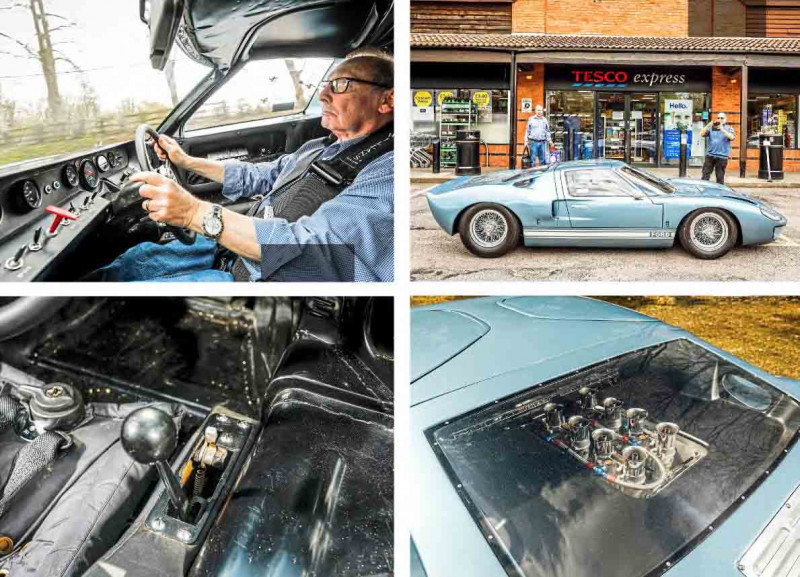
The GT40’s potential can never be met here – but it’s still an incongruous joy to experience.
Little space for shopping bags in the GT40’s ‘frunk’ MkIs used the 4.7-litre HiPo V8s as found in the Shelby Mustangs.
At road speeds the V8 needs all the cooling it can get.
Bullet mirrors do little to enhance peripheral view.
Five-speed is a joy to row through gears.

Reclined seating position hardly aids poor visibility Wait until they find out it’s not a replica… Weber trumpets showcased like the artworks they are.
V8 blare offers a beautiful retort to 2023’s whispering EVs and three-cylinders.
Fuel tanks in either sill; occupants in intimate proximity.
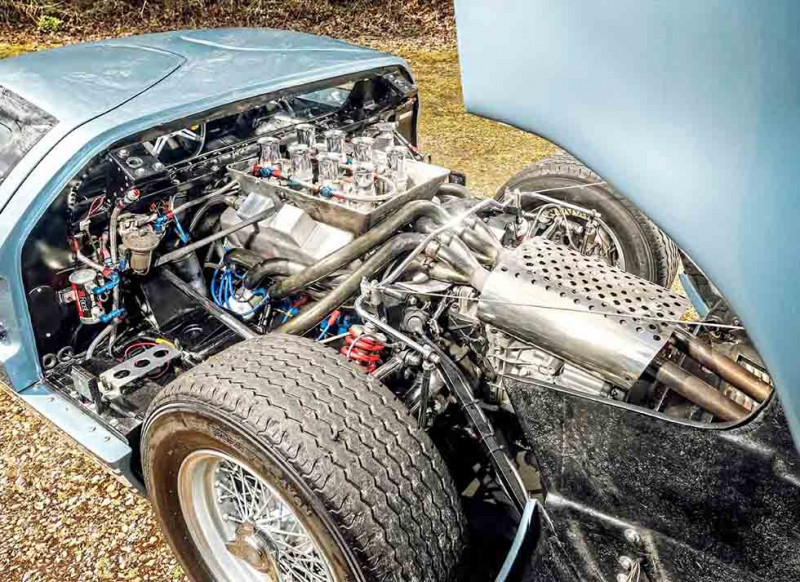
Low angle provides rare glimpse of venting to 4.7 V8.

Being handled by airport crew ahead of 1967 Geneva show, after which it was ‘kidnapped’; Graham Hill tries it for size in 1969; back at the Geneva show, 1969.


